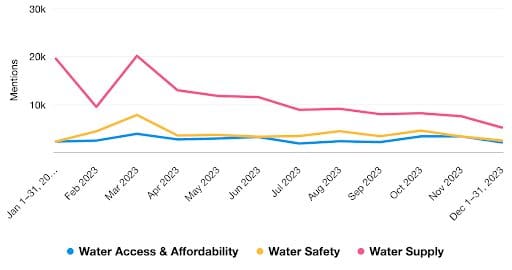Last year, our annual water media scan looked back on trends in coverage across water supply, water access & affordability, and water safety news from the previous year. Over the years, we’ve noticed a correlation between water’s weather and news cycle covering water use and supply. Seasonal stories are driven by the direct impacts of extreme weather like drought and flooding, as well as big reports like the Fifth National Climate Assessment, the first global water conference in 50 years, and a constant stream of federal funding announcements.

Water media forecast
In addition to looking back, we are charging ahead. Last year, we focused our annual narrative predictions around the term resilience and focused on themes that underpinned what it means for communities to respond to and prepare for extreme storms, flooding, and drought. This year is really focused on uncertainty, and how far the new administration will go clawing back federal funds for water priorities.
Here are five themes we’re tracking for 2025:
What Trump 2.0 means for water
This one is obvious but inescapable. As many advocates and experts feared, the Trump administration attacked U.S. climate policy, pausing Inflation Reduction Act and Bipartisan Infrastructure Law funds, on day one. We’re hoping journalists cover not just the process stories of whether water conservation and infrastructure funds are stalled but the economic cost of outdated water infrastructure. For example, water outages due to the deep freeze in Richmond, Virginia are costing families and businesses. Delaying or rolling back newly implemented drinking water rules for PFAS, lead pipes and other clean water programs and policies will ultimately cost people more in healthcare costs and lost property values.
The future of the Colorado River
Pausing Inflation Reduction Act funds spells big trouble for some Colorado River conservation projects. The Colorado River’s current water sharing agreement will also expire during Trump’s term. In November, the Bureau of Reclamation released four different and competing management rules as proposed by the Upper Basin states, Lower Basin states, Tribes, and the conservation community. The players are now awaiting Reclamations’ next steps. We’ll be watching to see if there are personnel and priority shake ups under Trump’s Reclamation and whether a fairly far along process will carry on with a lot of continuity amongst state negotiators and other collaborators.
Unnatural disasters
That climate change is wreaking havoc on water systems is old news at this point. But, as Daniel Rothberg pointed out in his latest Western Water Note, misinformation is its own kind of disaster. Mis- and disinformation floods social media (remember Hurricane Helene?) during extreme weather and recovery. This problem is best solved by good reporting and smart social media policies. We hope the decline of social media moderation doesn’t make it harder for people to get the immediate information they need in a disaster.
Additionally, while FEMA disaster prevention and relief funds don’t always reach communities with the greatest need, they remain an essential lifeline in this age of superstorms. Project 2025 proposes weakening FEMA and cutting funds for weather forecasting. Many states and cities that helped to elect Trump have benefited from federal disaster funds, including preparedness dollars in the Inflation Reduction Act that President Trump has vowed to repeal. It would be interesting to cross-reference electoral maps with FEMA data sets to learn whether climate politics reflect weather realities.
Why isn’t water too big to fail?
The federal government has bailed out banks, airlines, and automakers in times of crisis, yet the same hasn’t been true for America’s drinking water and wastewater systems. It’s a particular challenge for chronically failing systems that serve small, rural communities and don’t have the tax base to fund much-needed fixes. Why are these essential systems left to crumble?
Sixty billion in federal water funding from the Bipartisan Infrastructure Law and Inflation Reduction Act felt like a life-saving transfusion. But the EPA’s own needs assessment found drinking water systems alone “will need $625 billion for pipe replacement, treatment plant upgrades, storage tanks, and other key assets to ensure the public health, security, and economic well-being of our cities, towns, and communities.” We will be encouraging journalists to examine the stark contrast between corporate bailouts and small water systems drowning in debt, driving up rates for residents while leaving vital repairs unfunded until shutoffs and boil water notices become the norm.
Food, Farming and Water
The Inflation Reduction Act included $19.5 billion in funding for climate-smart agriculture programs that are popular with producers and fully subscribed. We’d love to see continued reporting on whether popular public funds for sustainable agriculture and conservation get pulled, and whether these initiatives like the IRA programs have been implemented in a way that has the biggest water-savings and climate mitigation returns. But, funds are paused and the future of these programs faces a hostile environment in a Republican Congress. Extended through late 2025, a Republican trifecta will also now shape the next Farm Bill. What does that mean for farmers in historically underserved communities or regenerative agricultural producers who have received support from climate-smart and conservation programs?
What’s next?
Sign up for our Water Cooler newsletter to hear about our trainings and resources and follow us on LinkedIn, Bluesky, and Instagram.